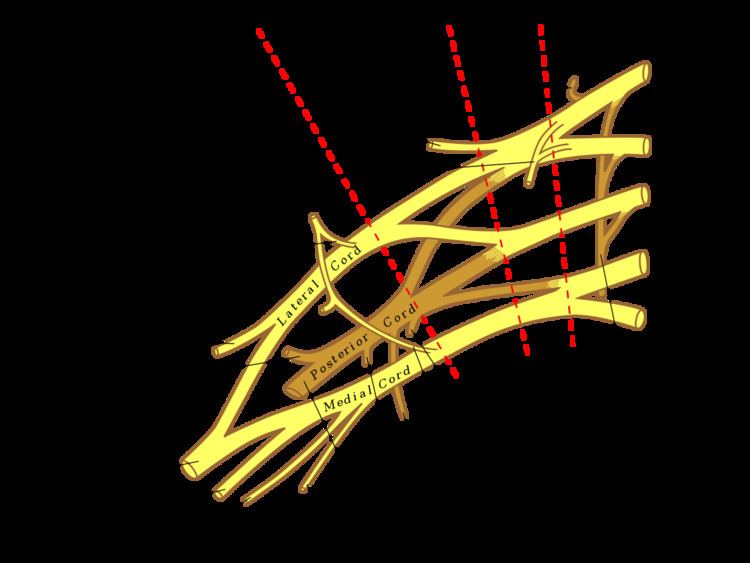Latin nervus axillaris TA A14.2.03.059 | Dorlands/Elsevier n_05/12565259 FMA 37072 | |
 | ||
Innervates | ||
The axillary nerve or the circumflex nerve is a nerve of the human body, that originates from the brachial plexus (upper trunk, posterior division, posterior cord) at the level of the axilla (armpit) and carries nerve fibers from C5 and C6. The axillary nerve travels through the quadrangular space with the posterior circumflex humeral artery and vein.
Contents
Structure
The nerve lies at first behind the axillary artery, and in front of the subscapularis, and passes downward to the lower border of that muscle.
It then winds backward, in company with the posterior humeral circumflex artery, through a quadrangular space bounded above by the teres minor, below by the teres major, medially by the long head of the triceps brachii, and laterally by the surgical neck of the humerus, and divides into an anterior, a posterior, and a collateral branch to the long head of the triceps brachii branch.
Function
The axillary nerve supplies three muscles in the arm: deltoid (a muscle of the shoulder), teres minor (one of the rotator cuff muscles) and the long head of the triceps brachii. Traditionally, the axillary nerve was thought to only supply the deltoid and teres minor. However, a study conducted in 2004 determined that, in 20 cadaveric specimens and 15 surgical dissections on participants, the long head was innervated by a branch of the axillary nerve in all cases.
The axillary nerve also carries sensory information from the shoulder joint, as well as the skin covering the inferior region of the deltoid muscle - the "regimental badge" area (which is innervated by the superior lateral cutaneous nerve branch of the axillary nerve).
The posterior cord of the brachial plexus splits inferiorly to the glenohumeral joint giving rise to the axillary nerve which wraps around the surgical neck of the humerus, and the radial nerve which wraps around the humerus anteriorly and descends along its lateral border.
Clinical significance
The axillary nerve may be injured in anterior-inferior dislocations of the shoulder joint, compression of the axilla with a crutch or fracture of the surgical neck of the humerus. An example of injury to the axillary nerve includes axillary nerve palsy. Injury to the nerve results in:
